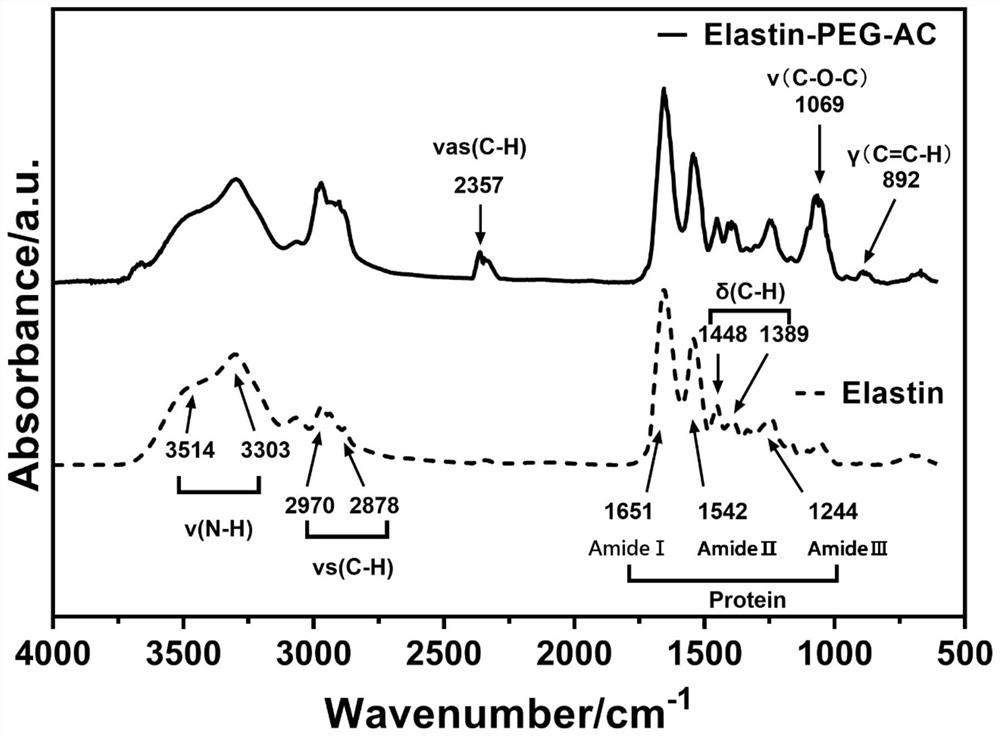Method for culturing organoid by using elastin hydrogel
A technology of elastin and hydrogel, applied in the biological field, can solve the problems of intramolecular cross-linking, large molecular weight, and many reaction steps, and achieve improved cell adhesion, high efficiency of modified grafting, and high production efficiency Effect
- Summary
- Abstract
- Description
- Claims
- Application Information
AI Technical Summary
Problems solved by technology
Method used
Image
Examples
Embodiment 1
[0041] This embodiment provides a modification method of photocrosslinkable elastin, which is prepared according to the following steps: 0.05 g of soluble elastin is dissolved in 10 mL of 0.01 M phosphate physiological buffer at pH 8.0 to prepare an aqueous elastin solution. 0.01 g of methacrylate-polyethylene glycol-N-hydroxysuccinimide (polyethylene glycol polymerization degree of 4) was added to the above-mentioned elastin aqueous solution, and the reaction was stirred for 3 hours under normal temperature and nitrogen atmosphere. The reactants were dialyzed in a dialysis bag with a molecular weight cut-off of 3 kDa for 48 hours, and then the purified protein solution was lyophilized in a freeze dryer to obtain modified elastin.
Embodiment 2
[0043] This embodiment provides a modification method for photocrosslinkable elastin, which is prepared according to the following steps: 0.2 g of soluble elastin is dissolved in 10 mL of 0.01 M phosphate physiological buffer at pH 8.0 to prepare an aqueous elastin solution. 0.1 g of methacrylate-polyethylene glycol-N-hydroxysuccinimide (polyethylene glycol polymerization degree of 20) was added to the above-mentioned elastin aqueous solution, and the reaction was stirred for 0.5 hour under normal temperature and nitrogen atmosphere. The reactants were dialyzed in a dialysis bag with a molecular weight cut-off of 3 kDa for 48 hours, and then the purified protein solution was lyophilized in a freeze dryer to obtain modified elastin.
Embodiment 3
[0045] This example provides a modification method of photocrosslinkable elastin, which is prepared according to the following steps: 0.15 g of soluble elastin is dissolved in 10 mL of 0.01M phosphate physiological buffer at pH 8.3 to prepare an aqueous elastin solution. 0.08 g of methacrylate-polyethylene glycol-N-hydroxysuccinimide (polyethylene glycol polymerization degree of 10) was added to the above-mentioned elastin aqueous solution, and the reaction was stirred for 2 hours under normal temperature and nitrogen atmosphere. The reactants were dialyzed in a dialysis bag with a molecular weight cut-off of 3 kDa for 48 hours, and then the purified protein solution was lyophilized in a freeze dryer to obtain modified elastin.
PUM
 Login to View More
Login to View More Abstract
Description
Claims
Application Information
 Login to View More
Login to View More - R&D
- Intellectual Property
- Life Sciences
- Materials
- Tech Scout
- Unparalleled Data Quality
- Higher Quality Content
- 60% Fewer Hallucinations
Browse by: Latest US Patents, China's latest patents, Technical Efficacy Thesaurus, Application Domain, Technology Topic, Popular Technical Reports.
© 2025 PatSnap. All rights reserved.Legal|Privacy policy|Modern Slavery Act Transparency Statement|Sitemap|About US| Contact US: help@patsnap.com



